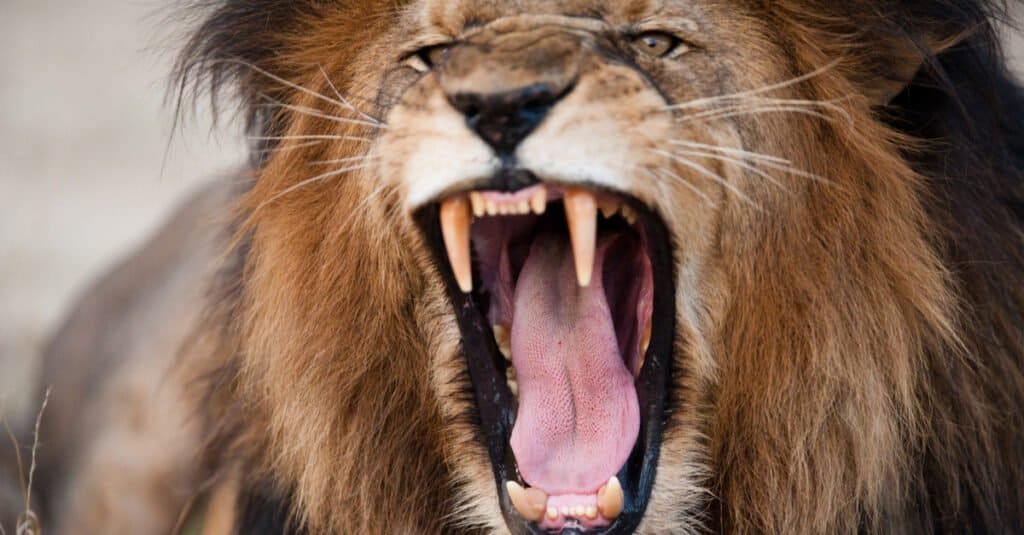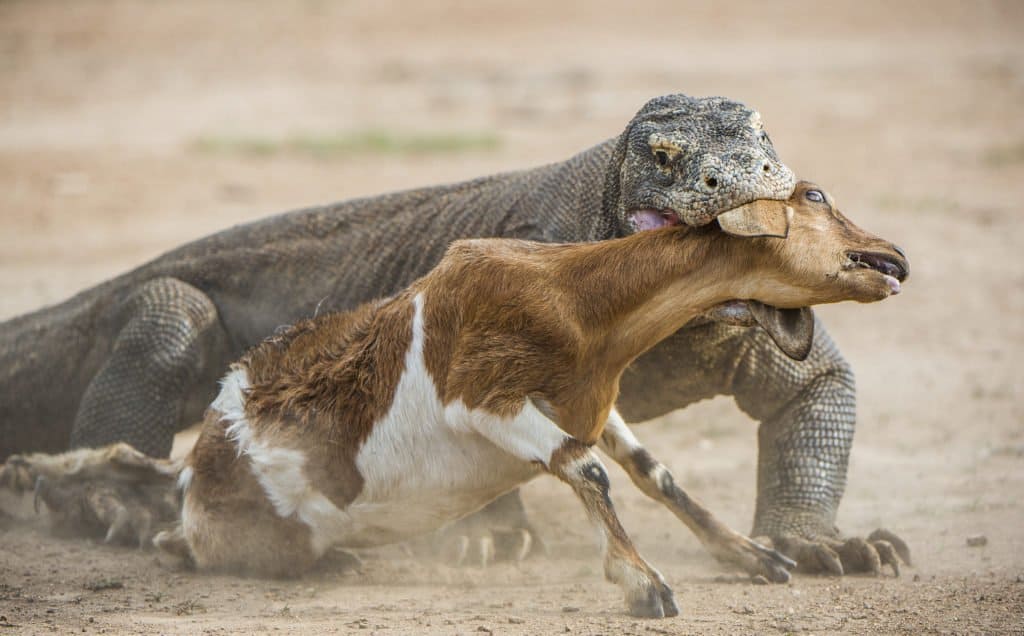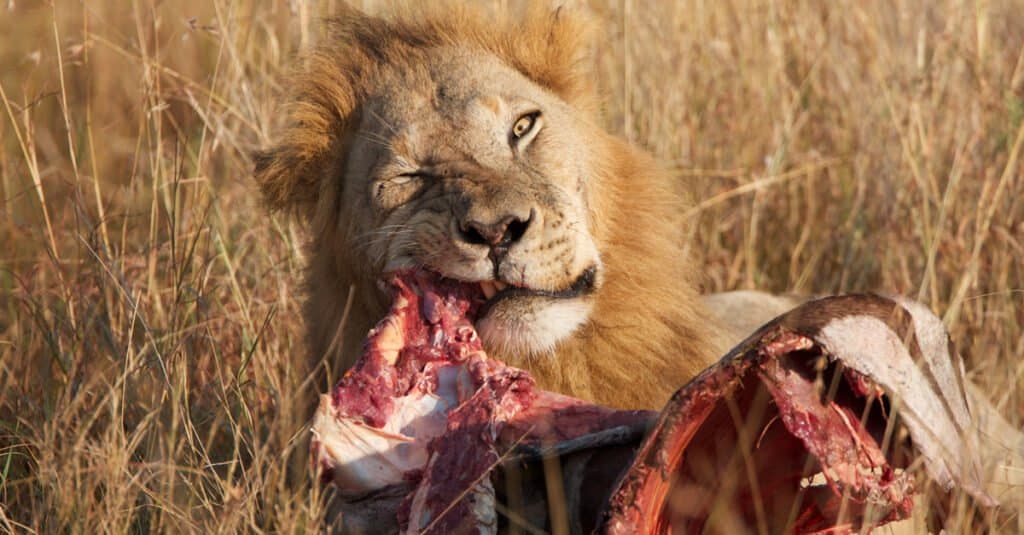Komodo dragons are regularly counted among the most frightening creatures on the planet. They are large, surprisingly fast lizards that hunt prey that is their size and larger. They have even killed human beings. In Africa, the lion reigns as the king of the jungle, and it has been known to kill humans as well. So, what would happen if these man killers came face to face and decided to fight? We’re going to break down a battle between a Komodo dragon vs. lion and show you how this fight will end!
Comparing a Komodo Dragon and a Lion

| Komodo Dragon | Lion | |
| Size | Weight: 150lbs – 300lbs Length: 6ft-10ft | Weight: 264lbs – 550lbs Length: 4.7ft – 8.2ft |
| Speed and Movement Type | 11 mph top speed | 35 mph |
| Senses | – Good eyesight – Use their tongues and Jacobson’s organ to smell and taste their environment and find prey from miles away – Poor hearing | -Amazing sense of sight, especially night vision. -Good sense of smell, capable of smelling other lions’ markings. -Great hearing allows them to hear prey miles away. |
| Defenses | – Hard skin with strong scales that are reinforced with bony deposits called osteoderms – Speed | Stays with pride for safety in numbers – Large size – Can quickly run away from enemies |
| Offensive Capabilities | – Possibly venomous – Sharp claws hold prey in place – Sharp teeth lead to exsanguination in victims | – Sharp claws can gash foes – Paw strikes can deliver a powerful, staggering blow – Strong biting power can splinter bones and tear prey open. |
| Predatory Behavior | – Ambush predators – Tries to knock down and bite vital areas on prey, typically the neck. | – Endurance predator or ambush predator – Works as a group to take down prey |
What Are Key Differences Between a Komodo Dragon and a Lion?

Lions and Komodo dragons have many unique qualities, but they’re both deadly predators.
©e2dan/Shutterstock.com
The biggest differences between a Komodo dragon and a lion are their size, socialization, and body type. Lions are heavier but not as long as Komodo dragons. They live in groups, whereas Komodo dragons live alone. Lions have a quadrupedal mammalian body with fur instead of a large, scaly lizard-like body.
Each of these differences makes the animals unique and has helped make each of them become apex predators in their respective habitats. We need to delve deeper into each animal’s abilities and unique traits if we are to determine which of them is going to win a fight against the other.
What Are the Key Factors in a Fight Between a Komodo Dragon and a Lion?

A komodo dragon vs lion fight will be settled by their brute strengths.
©Sergey Uryadnikov/Shutterstock.com
The key factors in a fight between a Komodo dragon and a lion are going to be related to their bodies, attacking methods, and whether or not they can sense their opponent before the fight begins. In most cases, an ambush predator that gets the first strike will instantly end the fight.
We’re going to look at five elements to help us determine just how strong each animal is and how they match up against one another.
Komodo Dragon vs Lion: Size
Lions are larger than Komodo dragons, and that size difference gives them a serious advantage. Lions stand taller off the ground, weigh up to 550 lbs, and grow 8.2 feet long. Komodo dragons can weigh over 300lbs and grow 10ft long, but a fair amount of that length is merely their tails.
Lions have a size advantage over Komodo dragons.
Komodo Dragon vs Lion: Speed and Movement
Lions are faster than Komodo dragons. A lion can move at 35 mph, rushing into and smashing its target. However, a Komodo dragon can only move at 11 mph. That means the lion will determine if they want to turn their tail and run; a fleeing Komodo dragon would be caught.
Lions have an advantage in terms of speed and movement.
Komodo Dragon vs Lion: Senses
Lions are great hunters that use their amazing night vision, powerful sense of smell, and strong hearing to sense animals over a mile away. Komodo dragons have good eyesight but poor hearing. However, they can use their tongues and Jacobson’s organs to smell and taste the air, tracking creatures from miles off.
Both animals have superior senses, so we’re going to say that neither has an advantage over the other.
Komodo Dragon vs Lion: Physical Defenses
Lions rely on their speed and their large size for physical defense. They have a loud threat display and can also stay with their pride for the sake of safety, too. Some of them also have manes that prevent them from being attacked at their neck, an important vital point.
Komodo dragons have reinforced scaly skin that is hard to bite through. Other than that, they rely on their speed and ability to swim and run upon the land to get away from serious trouble.
Komodo Dragon vs Lion: Combat Skills
Komodo dragons have strong combat skills. They’ll usually ambush their prey, knock them down, and set about biting their vital areas, tearing them apart. Komodo dragons may or may not be venomous, but one thing is for sure: they’ll use their sharp claws and weight to pin their prey while exsanguinating them with their serrated teeth.
Lions are just as deadly. They’re also ambush or endurance predators depending on whether they have their pride with them or not. When they get prey to the ground, they use a powerful bite and long teeth to deliver fatal injuries to their foes. They’ll use their weight, speed, teeth, and claws to kill their prey in a frenzy of fur and blood.
Who Would Win in a Fight Between a Komodo Dragon and a Lion?

Lions are powerful creatures that would ultimately take down a Komodo dragon.
©Richard Damian Knight/Shutterstock.com
A lion would win a fight against a Komodo dragon. Lions are larger and heavier and have something that the Komodo dragon lacks: the ability to kill their enemy with a single blow. Sure, the Komodo dragon has osteoderms that can prevent some damage from being done, but a lion can simply bite the less-guarded neck of the lizard and kill it very quickly.
That is not to say that the lion walks away without a scratch. Unless the lion ambushes, tackles, and lands a fatal blow in the first salvo, it’s going to get a fair share of cuts and bites. If it receives any bites, the wounds might not heal that well due to the unique saliva of the Komodo dragon.
Still, the statistics and advantages assigned in this battle favor a lion besting a Komodo dragon in a battle, even if it is a pyrrhic victory where the lion succumbs to wounds later.
What is the Biggest Thing a Lion Can Eat?
A lion may be the top predator in its environment, but it is still limited by what size of creature it can eat. Generally speaking, a lion will feed on prey that is smaller than itself. This includes small to medium-sized animals such as antelopes, wildebeest, warthogs, and zebras. In some cases, lions have been known to hunt and kill very large prey such as buffalo or even young rhinos. Additionally, lions are also opportunistic scavengers who will take advantage of carrion left behind by other predators if they come across it. They have even been seen hunting together in packs to bring down larger creatures like giraffes or hippos!
What is the Biggest Thing a Komodo Dragon can Eat?
Komodo Dragons are impressive creatures known for their formidable size and strength. They typically hunt by stalking their prey and can reach speeds of up to 11 mph. Komodo Dragons will consume a variety of smaller animals, such as insects, lizards, rats, birds, and rabbits. They can also devour much larger prey, such as horses, water buffaloes, goats, pigs, deer, and even other Komodo Dragons. In one case, a 101-pound Komodo Dragon managed to consume an entire 90-pound wild pig without leaving anything behind! This remarkable feat of strength and appetite makes it clear why Komodo Dragons are one of the most feared apex predators in the world.
Can a Komodo Dragon Catch a Human?
While attacks on humans by Komodo dragons are pretty rare, these predators have, on occasion, been responsible for a number of human fatalities, whether in the wild or in captivity.
Over a 38-year period, records documented a total of 24 reported encounters involving attacks on humans, with five of these encounters resulting in fatalities.
While attacks by Komodo dragons are exceptionally rare, they do happen occasionally, often in moments when a park guard’s attention wavers or when an unfortunate traveler or hiker crosses paths with one.
What Kind of Teeth Do Komodo Dragons Have?
Komodo Dragons have vicious, saw-like teeth that are ideal for their diet of carrion and small animals. The upper jaw has about 50 teeth, and the lower jaw has about 60. The frontmost teeth, called canines, are particularly long and curved and are used for puncturing flesh and ripping meat. Next are smaller incisors which help to slice through hard skin or crush bones. Behind them are molars with flat surfaces that grind food down into smaller chunks for easier digestion. Their teeth are known for harboring deadly bacteria that can kill even large creatures. These features give Komodo Dragons incredibly strong jaws that can even be fatal to larger prey such as wild boar or buffalo!
What Kind of Teeth Do Lions Have?
Lions have four types of teeth: incisors, canines, premolars, and molars. The incisors are for biting off pieces of food. They are small and sharp, like a knife. Canines are long and curved, with a point at the end used for piercing meat or gripping prey. Premolars have multiple points to help tear through tough flesh, while molars have flat surfaces used for grinding up food into smaller pieces that can be swallowed more easily. Lions use their teeth to catch their prey and defend themselves in fights with other animals, such as tigers or leopards. Additionally, lions also use their powerful jaws to hold onto larger prey until they die from shock or exhaustion before consuming them whole!
The photo featured at the top of this post is © GUDKOV ANDREY/Shutterstock.com
Thank you for reading! Have some feedback for us? Contact the AZ Animals editorial team.






